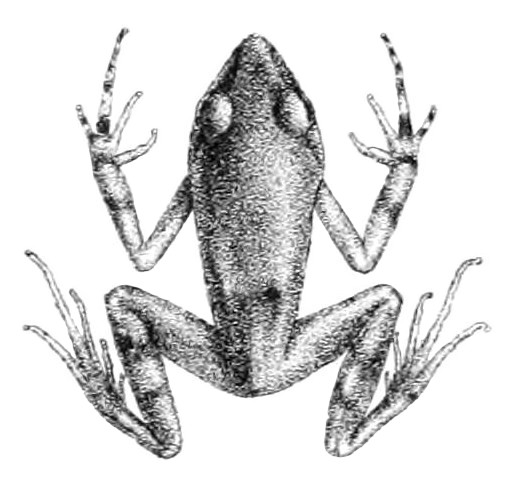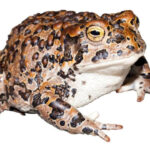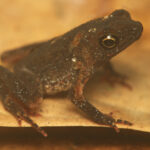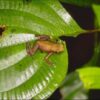- Exploring the Secretive Life of the West African Screeching Frog (Arthroleptis poecilonotus)
Exploring the Secretive Life of the West African Screeching Frog (Arthroleptis poecilonotus)#
In the dense, humid undergrowth of West Africa’s tropical forests, a creature moves stealthily over a carpet of leaf litter, hidden expertly by nature’s palette. For the curious observer, discovery often begins with a distinctive sound—a resonant, shrill whistle echoing through the twilight—the signature call of the remarkable West African Screeching Frog, scientifically known as Arthroleptis poecilonotus. Though small in stature, this striking amphibian plays a crucial ecological role within its lush habitat and represents a fascinating case study in evolutionary adaptation, behavior, and conservation.
Belonging to the Arthroleptidae family, commonly known as squeaker frogs, this species is not bound to permanent water bodies for survival, a fascinating adaptation we will unravel. Beyond its intriguing biological characteristics, the enigmatic life of Arthroleptis poecilonotus provides valuable insights into the complex ecology of West African rainforests, highlighting pressing conservation issues amidst a changing environment.
Taxonomy and Classification#
Understanding the rich story of this frog begins with its unique heritage in the larger tapestry of amphibian diversity. Arthroleptis poecilonotus is classified within the broader Arthroleptidae family, a lineage marked by its incredible adaptability within moist tropical habitats. Its genus, Arthroleptis, encompasses numerous ground-dwelling frogs known for their direct-developing offspring—an evolutionary marvel that frees these amphibians from relying on water bodies for reproduction.
This frog species has closely related counterparts in its genus, such as Arthroleptis variabilis and Arthroleptis sylvaticus, sharing similar adaptive strategies to thrive in complex forest ecosystems. Detailed taxonomic studies suggest that subtle variations in coloration and vocalizations help differentiate subspecies, highlighting their unique ecological niches and evolutionary pathways within West Africa’s ecosystems.
Natural Habitat: Forest Floors and Beyond#
Arthroleptis poecilonotus flourishes primarily in the lush rainforests spanning countries such as Côte d’Ivoire, Ghana, Cameroon, Equatorial Guinea, Nigeria, Guinea, Liberia, Sierra Leone, and Gabon. Here, beneath towering trees whose canopies obscure sunlight, the frog inhabits one of the most intricate yet overlooked layers of forest life—the leaf-littered ground.
An Oasis of Moisture and Stability#
Preferring shaded, humid environments, individuals nestle amidst fallen leaves, rotting logs, moss carpets, and occasionally, at forest edges bordering fields or plantations. Moisture-rich leaf litter provides a conducive microclimate, sheltering them from harsh sunlight and predators—an excellent zone for foraging and reproduction.
The environmental harmony existing on the forest floor creates an ideal hunting ground teeming with abundant invertebrate prey. Beneath the seemingly tranquil layer of decomposing plant matter lies a bustling miniature world where spiders dart between fungi-covered wood, insects burrow into soft earth, and snails glide lazily beneath tender, decaying foliage—all potential meals for the ever-watchful predator, Arthroleptis poecilonotus.
Physical Characteristics: Form and Function#
The West African Screeching Frog, although modestly sized—around 25 to 35 millimeters in total body length—possesses a remarkable appearance adapted impeccably to its shady environment. Mottled shades of brown, tan, rust, and olive spread across its slender body, each hue and pattern blending profoundly with the varying tones and textures of rainforest debris.
Distinguishing physical attributes include slender limbs and elongated digits, suited for agile navigation through tangled landscapes. The eyes, large and lustrous, perched prominently atop the head, grant exceptional peripheral vision, crucial for spotting distant movements of prey or predators alike.
This nuanced coloration and body morphology afford the frog unparalleled camouflage within its microhabitat, enabling it to evade hungry predators such as snakes or birds that scan forest floors for an easy meal. Adaptive camouflage is a key evolutionary weapon in ensuring survival, blending these frogs seamlessly into their surroundings until they are nearly invisible—unless movement betrays their presence.
Behavior and Life Cycle#
The complexity of Arthroleptis poecilonotus extends far beyond mere appearance. Their behaviors offer profound insights into the adaptive strategies evolved to navigate a harsh yet abundant world.
An Unconventional Lifestyle#
Unlike many amphibians that require pools, ponds, or streams for reproduction, this secretive species performs a unique evolutionary feat: direct development. Instead of depositing eggs in standing water, the female places eggs directly into the moist soil or leaf litter, bypassing a free-swimming tadpole phase entirely. Embryonic development takes place entirely within these terrestrial microhabitats, hatching fully formed froglets ready to negotiate the forest floor independently.
Such ecological and reproductive strategies dramatically increase offspring survivorship by minimizing aquatic predators’ threats and environmental risks inherent in transient water bodies—particularly advantageous during dry periods or ecological stress.
A Distinctive Serenade at Dusk#
An essential element of their behavioral repertoire is the male’s captivating mating call, bestowing the species its descriptive common name “West African Screeching Frog.” As dusk envelops the rainforest, males ascend leaf heaps or low plant stems, inflating their vocal sacs to emit rapid, high-pitched whistles—a symphony punctuating the evening chorus of jungle sounds. This shrilling serenade captures the attention of females and signals territory establishment, necessary for successful reproductive encounters.
Ecological Role: Hidden Guardians of Balance#
Despite their diminutive stature, these frogs occupy a substantial ecological niche, significantly shaping their rainforest ecosystems. Acting as voracious predators of insects and arthropods, they help maintain the biological checks and balances crucial for preserving biodiversity and forest health.
Furthermore, as prey, they provide essential nourishment to various predators including ecosystem-regulating snakes and birds. Their survival—and thriving—thus hinges strongly on intricate food webs that underscore ecological complexity and stability, making them indispensable participants in the West African ecosystems.
By serving as indicators of environmental quality, their presence—or absence—can signal critical informational feedback to conservationists monitoring habitat integrity and overall ecosystem health.
Threats and Conservation Status#
While currently listed by the IUCN as Least Concern due to their broad distribution and adaptability, emerging threats, nonetheless, cast uncertainty upon their futures. Habitat loss poses a significant, accelerating risk, with expanding agriculture, deforestation for logging, and urban encroachment eroding their once-pristine forest homes.
Silent Stresses on the Forest Floor#
The gradual degradation of rainforest habitats through farming activities or industrial expansion diminishes leaf litter and vegetation—critical microhabitats central to this frog’s existence. Moreover, climate change introduces longer drought periods and altered rainfall patterns, directly impacting humidity levels indispensably crucial for egg survival and juvenile development.
Proactive conservation policies—preserving intact forest landscapes, creating ecological corridors, and fostering awareness programs—are vital to sustaining the species and allies dependent on this incredibly biodiverse region.
Cultural and Scientific Significance#
Arthroleptis species, including poecilonotus, have traditionally featured in local folklore, symbolizing fertility and resilience due to their remarkable adaptation traits. Scientifically, research focusing on their unique physiological and behavioral traits contributes meaningfully to understanding broader evolutionary questions and conservation strategies applicable to amphibians worldwide.
As sentinel species inherently sensitive to environmental disturbances, these screeching frogs help scientists monitor ecosystem health and develop baselines to gauge future ecological impacts—highlighting the intricate bond between biodiversity conservation and human wellbeing.
Conclusion: Calls from the Forest Floor#
Arthroleptis poecilonotus embodies an enchanting story of adaptation, survival instincts, and underlying conservation significance set against the verdant backdrop of West African rainforests. As protectors of ecosystem balance and indicators of environmental change, their presence offers critical insights into sustainable practices benefiting humans and wildlife alike.
As advocates—whether scientists, naturalists, students, or conservation-conscious citizens—we bear the responsibility to champion conservation efforts. Let us amplify their quiet yet compelling calls echoing across forest floors, taking active roles in preserving the vibrant world these small, resilient frogs bravely navigate.













